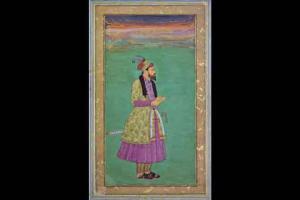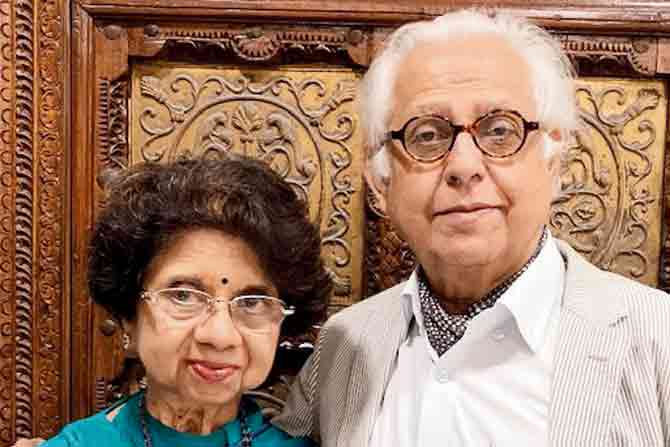Veteran British art curator Jeremiah P Losty studies a previously unpublished collection of miniature paintings from an Indian textile collector couple and finds rare works that help debunk historical errors.

Shah Jahan at the age of about 40; Mughal, 1690u00c3u00a2u00c2u0088u00c2u00921700. PICS COURTESY/Court & Courtship: Indian Miniatures in the TAPI Collection, Niyogi books
As a horse instinctively and blindly runs to his stable, our eyes invariably travel to the textile and pattern seen in a work of art—be it the Indus Valley priest dressed in the trefoil pattern garment, or a Chola bronze with a floral meander on the lower garment, or in Mughal, Deccani, Rajasthani or Pahadi miniatures," says veteran collector Shilpa Shah about the love for textiles she shares with husband Praful Shah. "We immediately ask ourselves, 'Could this pattern depict an embroidery? Or is it kalamkari or block print? Does the emperor's striped pyjama in a Mughal painting, represent a mashru?'"
This curiosity for textiles led the Mumbai-based couple to discover miniature paintings, which, Shilpa says, reflect the plethora of textiles used in costumes, and as tents, canopies and floorspreads in pre-colonial and colonial India. This made the paintings perhaps the only literary and visual record that existed prior to the British documenting the textile crafts of India. "It is an invaluable resource for visual evidence of textiles," she adds.
ADVERTISEMENT

Burhva Mangal (Boat Festival) celebration on the Ganga by Sukhdev Kishandas Gaur, Nathdwara, circa 1886
The couple is behind the Textiles & Art of the People of India (TAPI) collection, which apart from rare historical textiles, comprises a treasure-trove of artworks from the 16th to 18th century, featuring kings, princes, courtiers, ladies of the zenana, the divine durbars and goings-on of gods and goddesses, and courtship—the dalliance and romance, the pangs of separation and ecstatic union of lovers.
Ninety of these paintings have been closely examined in a recently-published book, Court & Courtship: Indian Miniatures in the TAPI Collection (Niyogi Books), authored by Jeremiah P Losty, who curated Indian manuscripts and paintings at the British Museum and British Library in London for 34 years, until retiring in 2005.

Gopashtami celebration in a courtyard of Shrinathji's haveli, attributed to Ghasiram Sharma and workshop, Nathdwara, 1905−10. The Shahs say that these two works hold a special place in their heart
The project took off almost by accident. "We had invited Jeremiah to Mumbai to study our Company School paintings a few years ago. That visit led to his writing the exhibition catalogue, Indian Life and People in the 19th century: Company painting in the TAPI Collection. When he was here for the exhibition inauguration at the Chhatrapati Shivaji Maharaj Vastu Sanghralaya, we showed him our miniature paintings for his feedback. We respect his scholarship and incisive art historical knowledge. Knowing him never to be evasive or overpitch an artwork, we were excited that he thought there was meat and material enough in our paintings for him to study them in detail," says Shilpa.
While she admits that theirs is not the most "comprehensive" or "encyclopaedic collection" of miniature paintings, that's also what made it appealing to Losty. "It's a collection full of surprises, with some great paintings and most of considerable interest. The many and varied costumes worn by the participants reflect the Shahs' devotion to textiles, especially in the many paintings of women," he says, in an email interview to Mid-day.
His text begins by explaining the subject of the artwork, before offering the reader the art historical matrix, placing it in its chronological, stylistic and regional context. His scholarship and keen understanding of Indian art also help debunk historical and factual errors, if any. For instance, a portrait subject painted sometime between 1690 and 1700, "richly dressed in a lilac jama and gold brocade coat decorated with narcissi in a diaper pattern over brocade paijama and red shoes" has been identified as a certain Muhammad Mir Khan, son of Jafar Jang, in the inscription in reverse. But the person, he says, is far too grandly dressed for him to be anyone other than a Mughal prince or emperor in the 17th century. Losty says the painting resembles Shah Jahan from 1630s or 1640s, at about the age of 40, before his hair showed any hint of grey. "Shah Jahan's image is very well known and this seems to fit it exactly. His cloth of gold short coat and feather in his turban seemed to fix it. The inscription is a later one added in Rajasthan, naming a man who is hardly known, if at all. Such things can be accepted only if they accord with the visual evidence," Losty explains.

Praful and Shilpa Shah
The most fascinating find in this collection, he says, was the Nathdwara paintings—plates 73 and 74 in the book—from Rajasthan. The first is the Burhva Mangal (Boat Festival) celebration on the Ganga by Sukhdev Kishandas Gaur, circa 1886. The second is the Gopashtami celebration in a courtyard of Shrinathji's haveli, attributed to Ghasiram Sharma and workshop, 1905−10. "Both of them are attributable to named artists, one at the start of his career, the other at his height. Such paintings have never come my way before nor are indeed much seen outside of India," says Losty.
The Shahs too, remain partial to these two artworks, which they had acquired from the same collector, in the late 1990s. "They have a very special place in our hearts," says Shilpa. The couple learnt about these paintings from art historian and museologist Dr Anand Krishna, whom they had met during a visit to the Bharat Kala Bhavan at Banaras Hindu University in Varanasi. "One afternoon, we got an excited telephone call from him. He said he was in Delhi and asked if we could fly down [from Mumbai] to see him? He had spotted something—something quite different from the usual. The next morning we flew to Delhi, meeting Raja Bhaiya, as we fondly called Dr Krishna, at a collector's place, an address near Connaught Place. We were shown two large paintings by two famous artists of Nathdwara. Raja Bhaiya explained, 'Every age has its masters. Collectors tend to go for early paintings, but it is equally important to take note of master painters of the 19th and 20th century and not write them off as 'late works'."

Jeremiah P Losty
Losty's personal favourites, however, are plates 12 and 13 in the book. "The former [Tailangi ragini, a page from a Ragamala series, 1680-85] is a stunning representation of erotic tension, that I saw and handled when it was in London some years ago. The second [Sugriva espies Rama and Lakshmana approaching his mountain lair, 1700-10] is one of the finest paintings from the Shangri Ramayana with the characters really interacting and expressing themselves," he says.
One of his motivations behind the project was also to address the dearth of studies on miniature paintings in India.

Tailangi Ragini, a page from a Ragamala series, 1680-85. Losty'a personal favourite, he calls it a "stunning representation of erotic tension"
"Most art historians concentrate on sculpture and architecture, with relatively few specialists for paintings. This is a shame since paintings were the dominant method of expression for Indian artists from the 16th to the 19th centuries. It would certainly help their profile if Indian museums put their collections online as Western ones are doing increasingly. Very few indeed have actually published catalogues of their collections."
Keep scrolling to read more news
Catch up on all the latest Mumbai news, crime news, current affairs, and a complete guide from food to things to do and events across Mumbai. Also download the new mid-day Android and iOS apps to get latest updates.
Mid-Day is now on Telegram. Click here to join our channel (@middayinfomedialtd) and stay updated with the latest news
 Subscribe today by clicking the link and stay updated with the latest news!" Click here!
Subscribe today by clicking the link and stay updated with the latest news!" Click here!







